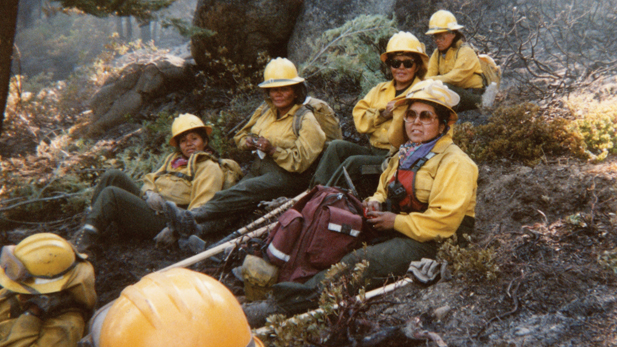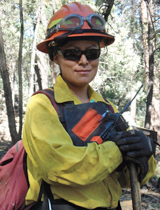 The Apache 8 crew pauses during another long day on the scene of a wildfire.
The Apache 8 crew pauses during another long day on the scene of a wildfire.On the frontlines of the more than 500,000-acre Wallow Fire, amid the trees and smoke and the 4,000 yellow-clad figures fighting to save homes and lives, a handful of women stand out.
Their calm, quiet efficiency marks them as veterans of Apache 8, an all-female, all-Apache firefighting crew that battled the West’s worst blazes for over 30 years before going co-ed in 2005.
The women who served in the Apache 8 ranks—all of them members of the White Mountain Apache Tribe—earned a reputation for bravery and excellence. Their longtime crew boss, Cheryl Bones, was honored with selection as the sole woman model for the Wildland Firefighters Monument.
And, more recently, a documentary has taken their story far beyond the reservation’s borders.
Apache 8 re-airs Sunday, June 19 at 5 p.m. on World.
"They can climb the highest mountain, carry the heaviest burden on their back and still put out the fire,” says Ronnie Lupe, chairman of the White Mountains Apache Tribe, in the film, which is titled Apache 8. “We are so proud of them."
Sande Zeig, the Tucson-based writer and filmmaker (and former Loft Cinema director) who directed and produced Apache 8, came across the elite crew by chance.
Zeig was walking through Phoenix Sky Harbor International Airport toward the shuttle when she passed a group of women in yellow shirts. Their intensity stopped Zeig in her tracks.
“The air was just vibrating around them,” Zeig recalls. “I asked who they were, and they said they were Apache firefighters. And ‘I want to make a film about you’ just came out of my mouth.”
Zeig secured permission from the tribal council—“They were very reticent about letting white people film on the reservation, understandably,” says Zeig—and spent more than a year watching the women thin forests and run prescribed burns, listening to their stories of loss and struggle, and even venturing with them into the wildfires they fight.
As Zeig spent more and more time with Apache 8, and as the women’s trust in her deepened, the film’s narrative began to take surprising turns.
Zeig found herself focusing on the lives of four crew members—Bones, Ericka Hinton, Katy Aday and Nita Quintero—who represent the multi-generational spectrum of Apache 8 women.
The film follows Bones as she copes with two profound blows: the death of her Apache Hotshot nephew in a controlled burn, and her daughter’s murder on the reservation. It explores Aday’s childhood with a Mormon family in California and her distinguished military career, Quintero’s coming of age and unique family, and Hinton’s remarkable drive to fight fires.
Hinton joined the Apache 8 crew for a 14-day stint when she was barely out of high school and in need of a job to provide for her family and her son. Those two weeks shaped the rest of her life.
 Young Apache 8 veteran Ericka Hinton is the first woman to join the elite Apache Hotshots firefighting team.
Young Apache 8 veteran Ericka Hinton is the first woman to join the elite Apache Hotshots firefighting team.“The ladies said, yes, fire fighting can be hard, but if you can handle it, you should keep going,” she says.
Hinton heeded their encouragement and, in 2009, became one of the first two women to join the ranks of the Apache Hotshots in their 27-year history.
She is currently with her Helitack crew in Whiteriver, providing Wallow Fire support and waiting to be called into firefighting duty should the fire spread into the Fort Apache Reservation.
See a map of the White Mountain Apache Reservation
Although she admits she was nervous about taking part in the Apache 8 documentary, Hinton says the experience was positive in the end.
“I consider Sande a friend and hope I don’t lose contact with her,” she says. “She’s a great person.”
Discovering Apache 8 and telling its story has been positive for Zeig as well. She lost her longtime partner shortly before the project began, and says it helped her heal after the loss.
“The Apache had a prayer with a medicine woman to bless us [the filmmakers] in bringing our presence onto the reservation, and I was touched by that,” says Zeig. “I felt happy up there, comfortable and peaceful.”
Now, as the film wends its way through the festival circuit and onto screens across the country, Zeig hopes to share the healing.
“As a filmmaker, you’re in a position to heal or stir up trouble,” she says. “I want this to be healing.”
But for the Apache 8 women now on the frontlines and for the lands and people they are protecting, healing is a thought for the future. The present is just about beating back the flames.
Quintero, who had served with Apache 8 since the 1980s and is now fighting the Wallow Fire, didn’t even have a moment to reflect on the blaze she’s battling into containment.
“I just don’t have the time, hon,” she said, and went back to the hard work at hand.
Watch the full episode. See more PBS NewsHour.
Read more about Arizona's ongoing battle with wildfire at the AZPM Fire Hub.

By submitting your comments, you hereby give AZPM the right to post your comments and potentially use them in any other form of media operated by this institution.